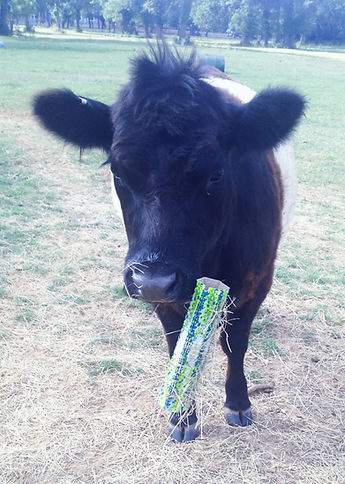
New Cattle? Now What??
HERD HEALTH
First off, I need a disclaimer, I am NOT an expert. Please speak with your vet or county extension agent about these topics. They ARE experts. I am just trying to provide the basis for good questions and a few online resources. There are vets and companies that offer a "herd health" service. If you are just starting out or trying to make the most of your business, getting a professional opinion is worth every penny. The areas I'm going to touch on are feed, vaccinations, and parasite control. This is by no means complete, so please do your own research. Your county extension agent is a great place to start for questions. This "Cattlemans" article gives some great tips and considerations on creating a herd health calendar.


FEED
Cattle require energy, protein, minerals, and vitamins in their diet. Cattle will consume approximately 2% of their body weight per day in roughage (grass or hay). Lactating cows consume more, and cattle in cold conditions will consume more. Cattle are designed to eat. Having pasture or hay available free choice is ideal. Even in an ideal pasture, cattle will need a good quality, loose mineral available free choice.
If your forage is limited, poor quality, low in energy or low in protein then, you should supplement with feed, range cubes, and/or protein tubs. You probably need to feed your cattle! Especially if they are growing, pregnant, or nursing. Body condition scores are a good way to decide if you should dig deeper into your nutrition program.
VACCINATIONS
Cattle vaccines are regional. Check with your vet or extension office to find what is recommended in your area. Read the label, not all vaccines are created equal, most need to be refrigerated, some need to be used or thrown out after opening. First-time vaccinations should be followed by a booster, usually 4-6 weeks later, then repeated yearly. Some modified live vaccines are not safe for pregnant cows but get a better immune response.

PARASITE CONTROL

For my purposes, I am going to include both internal and external parasites. Beginning with internal parasite control. This is another good topic to confer with your vet. I have a very small place, therefore, I worm my cattle more frequently than someone on a much larger place.
You have several options in dewormers; pour-on, injectable, and oral. Pour-on wormers are easy to administer. They are almost all ivermectin derivatives. Rotational worming does not mean switching brands of pour-on! Injectable wormers have many options. The oral wormers can be fed, licked, (it is difficult to be sure everyone is getting enough in a herd setting) or drenched. A good link to compare types and what parasites they address can be found at PBS Animal Health
For me personally, I like SafeGuard in the spring. I've found my cattle shed out faster and look better than anything else I've tried. And a pour-on in the fall and winter to help address the possibility of lice. I worm every three months, I've tried various products in between.
External parasites include flies, lice, and ticks. Fly control should be addressed from a couple of angles. The first is the environment. Keep it as clean as possible. The goal is to reduce fly larvae. That means either picking up poop or breaking up poop. Poultry can help with this although they can attract flies if their area isn't kept clean as well. Use something to discourage flies from breeding in the manure. I use fly predators, an IGR would also be effective. IGR can be fed or used as a premise spray. The second thing is to address the existing adult flies. Stinky traps should be hung away from the barn (for many reasons), while sticky traps work well in the barn, on the fence, or anywhere cattle congregate. (Just not somewhere they can reach, sigh) They are most effective at knee level and in the sun. The third is something to keep the flies off the cattle themselves. You can spray your cattle regularly with a water-based repellent (horse fly spray), or use an oil-based pour-on that lasts several weeks. Bump bags or rollers can also help. Fly tags are an option as well but need to be handled with care.
